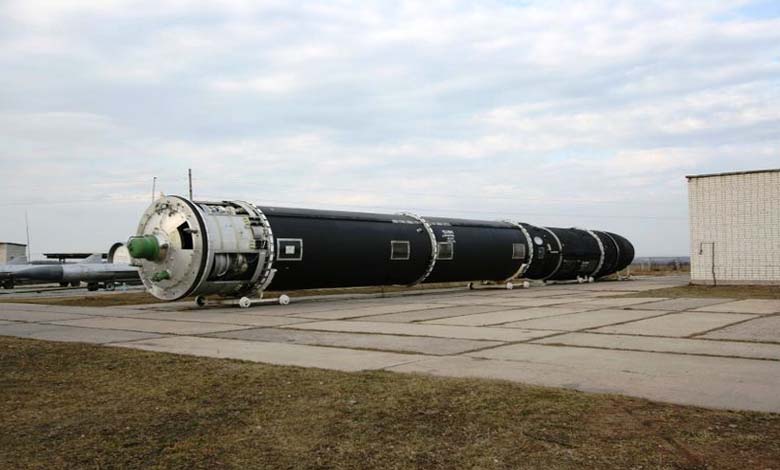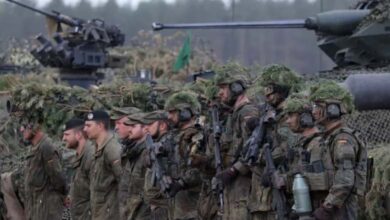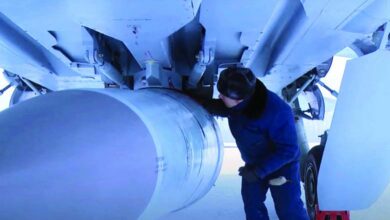Flying Chernobyl: Russia Preparing to Test Doomsday Missile

In a dramatic military development reminiscent of the most tense moments of the Cold War, Russia is preparing for a new test of its strategic nuclear missile known as the “Doomsday” weapon.
The missile, nicknamed the “Flying Chernobyl” by Russians, relies on a unique technology powered by a nuclear propulsion engine, theoretically granting it unlimited range, according to the UK’s Express newspaper.
-
Nuclear War Message: The Soviet Dead Hand Confronts America’s Doomsday Missile
-
Doomsday Weapons: Who Owns Them and Where Are They Stored?
Under Russian design concepts, the weapon could remain airborne for weeks or even months within global airspace, awaiting a launch order, before striking its target via unpredictable flight paths designed to evade all current detection and interception systems.
Experts argue that this makes it one of the most concerning weapons since the invention of the hydrogen bomb.
Signals from space and sea indicating readiness
Recent satellite imagery and intense activity at the Pankovo test range in the Novaya Zemlya archipelago, north of the Arctic Ocean, reveal clear signs that launch preparations are nearing completion.
-
The “Orechnik” Surprise: The Russian “Terrifying” Missile Pulses with a Western Heart
-
Intercontinental Missile Warfare: Russia Launches a Ballistic Missile at Ukraine
The images show four Russian ships, previously docked near the site, moving to observation positions in the eastern Barents Sea — a standard military protocol during ballistic or nuclear missile tests.
In parallel, Russian aviation authorities issued a Notice to Airmen (NOTAM) covering a vast area of roughly 40,000 square kilometers above the region, effective from 9 p.m. GMT last Thursday until next Tuesday evening.
In recent weeks, heavy shipping traffic to the archipelago has been recorded, indicating large-scale logistical activity. Additionally, two aircraft belonging to Rosatom — the state nuclear energy corporation — were spotted at local airports, further suggesting that preparations are in their final phase.
-
Business Insider: Satellite Images Reveal 5 Secret Russian Nuclear Bases
-
Russia’s Summer of Fury: How Will Putin Respond to Spider Web?
A new-generation strategic weapon
Russian President Vladimir Putin first unveiled the 9M730 Burevestnik missile in 2018 as part of an “unmatched” arsenal aimed at maintaining Russia’s strategic edge over Western capabilities.
According to Moscow, the missile can carry a nuclear warhead and bypass any air defense system in the world, thanks to its maneuverability and ability to fly at low altitudes along unconventional routes.
-
Broadcasting the Apocalypse Signal: Mysterious Messages Hint at a Russian Superweapon
-
Japan Doubles Shelters… Preparing for World War III?
However, the project has faced a series of technical failures. U.S. intelligence assessments indicate that by October 2023, Russia had conducted 13 test launches of the missile, none of which were fully successful.
The longest recorded flight lasted just two minutes and covered only 35 kilometers — far below the stated ambition. Experts believe the greatest challenge lies in developing a nuclear engine that is both safe and efficient enough to operate for extended periods without triggering catastrophic radiation leaks.
-
Ukraine after the Suspension of U.S. Aid: Implications and Options
-
“Shadow War”… Europe Plans an Attack on Russian “Ghosts”
While Moscow describes the weapon as a “balancing” element to deter any Western threat, analysts argue that its development and testing at this particular moment send a strong political and military message, especially amid the ongoing war in Ukraine and heightened rhetoric and reciprocal sanctions with NATO.












